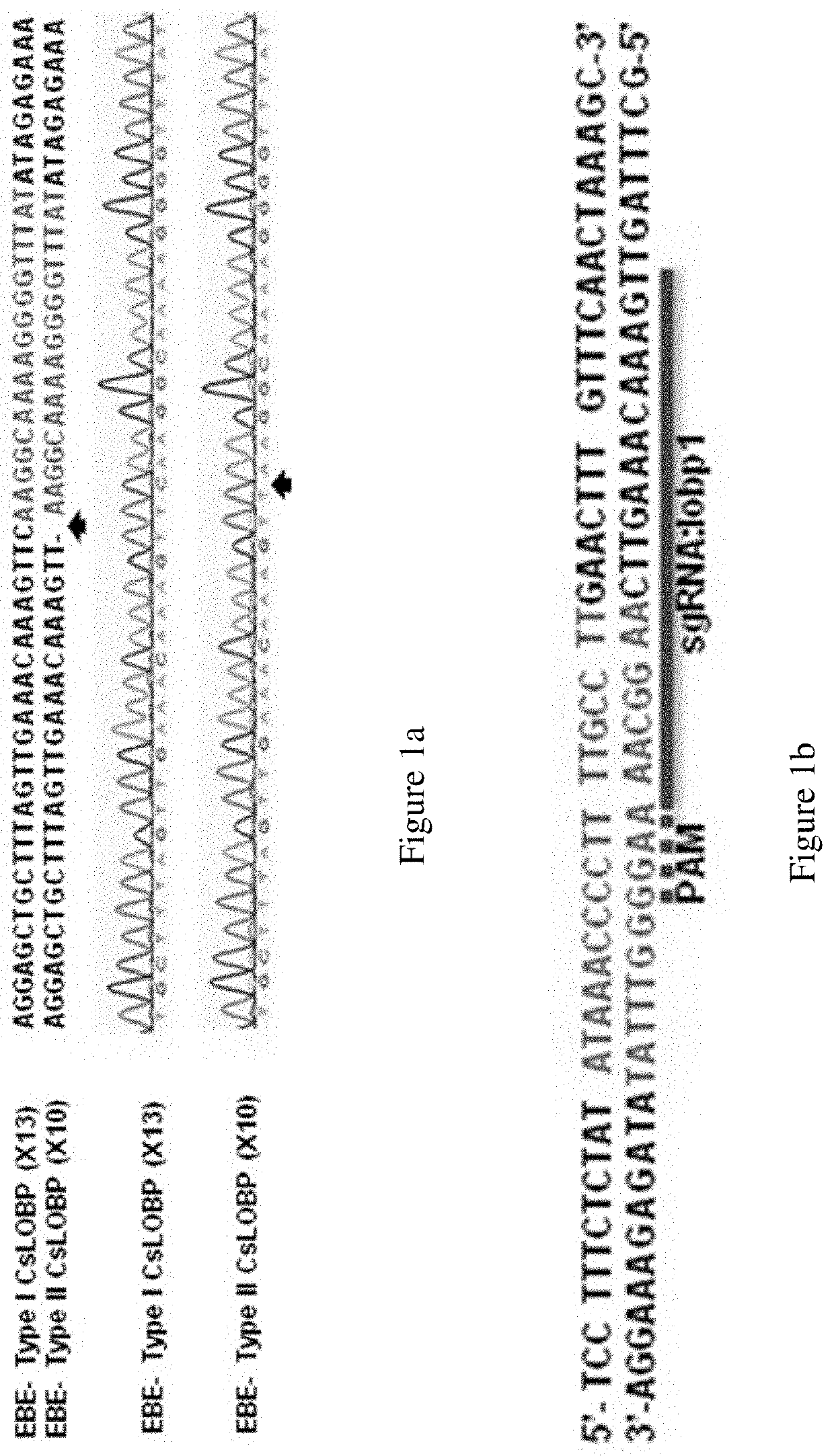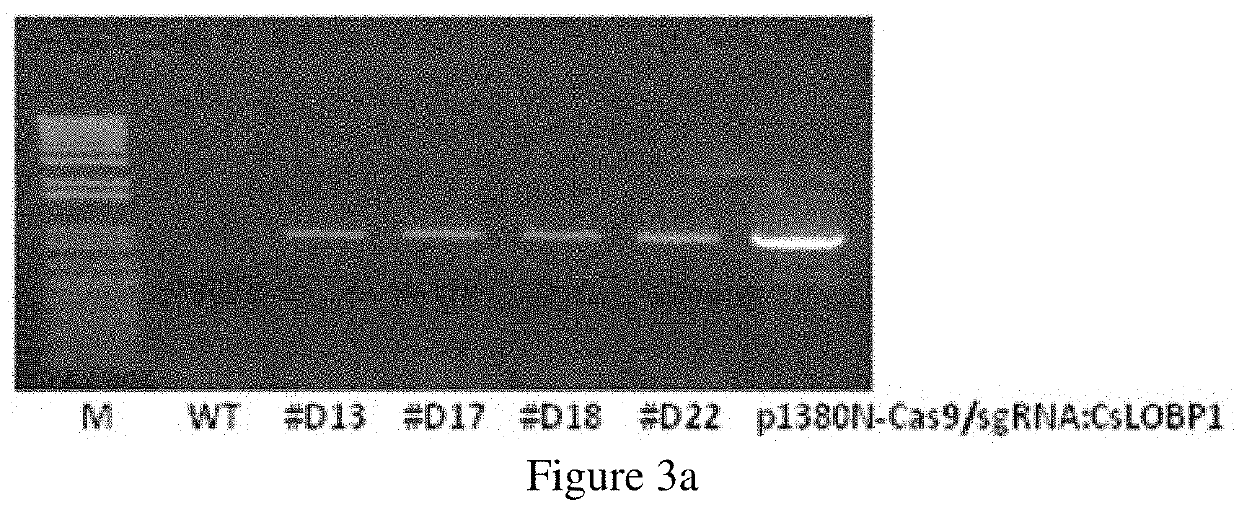Citrus varieties resistant to xanthomonas citri infection
a technology of xanthomonas citri and citrus, which is applied in the field of citrus varieties resistant to xanthomonas citri infection, can solve the problems of not being able to harness cas9/sgrna for genome editing in transgenic citrus, and the challenge of conventional breeding is grea
- Summary
- Abstract
- Description
- Claims
- Application Information
AI Technical Summary
Problems solved by technology
Method used
Image
Examples
example 1
of Cslob1 Promoters in Duncan Grapefruit
[0094]The Valencia CsLOBP was shown to be different from that of Duncan grapefruit. Grapefruit resulted from hybridization between pummelo (C. maxima) and sweet orange (C. sinensis). To identify whether Duncan grapefruit contains CsLOBP from both pummelo and sweet orange, CsLOBP was amplified from Duncan grapefruit and sequenced after blunt end cloning. Among 23 random colonies, thirteen contained the Valencia-type CsLOBP, which is designated as Type I CsLOBP, and ten were the same as pummelo CsLOBP, named as Type II CsLOBP (FIGS. 1a and 7). This is consistent with the report that two types of CsPDS gene are present in Duncan grapefruit. The two types of CsLOBPs are different in several regions (FIG. 7), and notably, one nucleotide C next to EBEPthA4 is missing in the Type II CsLOBP (FIG. 1a).
Example 2—Designing Cas9 / SGRNA:CsLOBP1 to Modify EBEPthA4-Type I (TI) CsLOBP in Duncan Grapefruit Via Xcc-Facilitated Agroinfiltration
[0095]Based on Type...
example 4
SGRNA:CsLOBP1-Transformed Plants were Susceiptible to Xcc
[0098]Four transgenic plants were treated with Xcc at the concentration of 5×108 CFU / ml. Typical canker symptoms were observed on the four independent transgenic lines similarly as the wild type control plants, at five days post inoculation (DPI) (FIG. 4a). No change in canker development was observed on #D18 and #D22, whose mutation rate on CsLOBP was 54.54% and 81.25%, respectively (Table 2). To test whether mutation of EBEPthA4-Type I CsLOBP affects PthA4 activation of CsLOB1 gene, Type I CsLOBP, Type II CsLOBP and mutant Type I CsLOBP were placed upstream of the GUS reporter gene to form p1380-TI CsLOBP-GUSin, p1380-TII CsLOBP-GUSin and p1380-MTI CsLOBP-GUSin, respectively (FIG. 4b). Via Xcc-facilitated agroinfiltration, GUS expression was detected in constructs containing Type I CsLOBP, Type II CsLOBP and mutant Type I CsLOBP (FIG. 4c), whereas no GUS expression was detected in the leaves treated by p1380-AtHSP70BP-GUSin,...
example 5
l dTALE dCsLOB1.3 Construct to Specifically Activate Type I CsLOBP
[0100]Two artificial dTALEs, dCsLOB1.1 and dCsLOB1.2, were constructed to activate CsLOBP. The dCsLOB1.1 binding site is TAAAGCAGCTCCTCCTC (SEQ ID NO: 90) and the dCsLOB1.2 recognition sequence is TATAAACCCCTTTTGCCTT (SEQ ID NO: 91) (FIG. 7). A novel dTALE, dCsLOB1.3 was constructed (FIG. 5a), whose repeat variable diresidues (RVDs) correspond to a 18-nucleotide sequence 5′-CCTTTTGCCTTGAACTTT-3′ (SEQ ID NO: 92) in the Type I CsLOBP (FIG. 7), whereas one nucleotide was missing or inserted in the Type II CsLOBP and the mutated Type I CsLOBP, respectively. dCsLOB1.3 was designed to activate Type I CsLOBP, but not Type II CsLOBP and mutant Type I CsLOBP. The dCsLOB1.3 binding sequence is preceded by a cytosine at position zero (FIG. 5a), which was reported to be applicable for dTALE activation. In addition, the RVD of dCsLOB1.3 located at 11 is NH, which was reported to be highly specific for guanine. As shown in FIG. 5b,...
PUM
| Property | Measurement | Unit |
|---|---|---|
| temperatures | aaaaa | aaaaa |
| threshold | aaaaa | aaaaa |
| volume | aaaaa | aaaaa |
Abstract
Description
Claims
Application Information
 Login to View More
Login to View More - R&D
- Intellectual Property
- Life Sciences
- Materials
- Tech Scout
- Unparalleled Data Quality
- Higher Quality Content
- 60% Fewer Hallucinations
Browse by: Latest US Patents, China's latest patents, Technical Efficacy Thesaurus, Application Domain, Technology Topic, Popular Technical Reports.
© 2025 PatSnap. All rights reserved.Legal|Privacy policy|Modern Slavery Act Transparency Statement|Sitemap|About US| Contact US: help@patsnap.com



